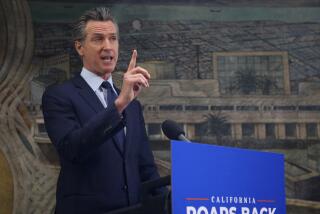Aquarium Gets State Aid as Revenue Drops
- Share via
Faced with falling attendance and sagging revenue, Long Beach aquarium officials suffered a setback Friday when Gov. Gray Davis gave the struggling tourist attraction a fraction of the $2.4 million in state aid they had been seeking.
Aquarium of the Pacific’s supporters, who once promised the facility would require no public funding, now say the state money is necessary to help cover operating costs and free up other money to make interest payments to bondholders.
But Davis on Friday approved only $500,000, heightening the scramble by aquarium officials to save money and find other public and private financing.
“We are thankful for the $500,000,” said Warren Iliff, aquarium president and chief executive officer. “It would have been nice to have gotten more. The outlook is good, but we will have to work hard and look for new sources of money and ways to save money.”
The $120-million aquarium opened in June 1998. Beforehand, top city officials--armed with a feasibility study--forecast that it would draw crowds of 2 million people a year, more than enough to pay for construction, operation and debt service.
The most recent report to aquarium bondholders, however, revealed a less glowing reality: Paid admissions during the busiest months--July through December--fell roughly 40% from 1998 to 1999.
If those trends continue, the numbers indicate, admissions this year may dip below the 1.4 million visitors necessary to meet the aquarium’s current annual budget of about $23 million. According to the current estimate by the aquarium, about 1.2 million people will visit the facility in 2000.
Iliff acknowledged Friday the original projections were based on faulty data.
The analysis “used stuff from other aquariums in other regions. It just didn’t compare and the extrapolations did not work,” he said.
Although the amount of state aid requested and received is rather modest, the attempt to secure government funding has once again stirred local critics who have long opposed the project.
“It’s a shame to see it, but the numbers were wrong in the first place,” said Joel Friedland, a former Long Beach harbor commissioner. “We are now beginning to reap the effects of those bad projections.”
Friedland and others are concerned the aquarium may be headed the way of other Long Beach tourist attractions, including the struggling Queen Mary and the failed exhibit of the Spruce Goose--the gigantic flying boat built by Howard Hughes.
City and aquarium officials contend, however, that the decline in paid admissions is typical of new attractions and only temporary. The trend should reverse, they say, when a $100-million entertainment and restaurant complex called Queensway Bay opens near the aquarium in late 2001--two years behind schedule. Ten million visitors a year are forecast for the center.
“When Queensway Bay is finished, critical mass will result and the aquarium will be completely self-sustaining,” said James C. Hankla, former Long Beach city manager who headed the project. He was one of several city officials who predicted the facility would not need government funding.
Part of Effort to Remake Long Beach
The Aquarium of the Pacific is one of the key components in the city’s effort to remake itself into a recreational mecca after the devastating recession of the 1990s, in which 50,000 local jobs vanished, primarily from the defense and aerospace industries.
With enough exhibit space to fill three football fields, the aquarium displays more than 12,000 animals from about 550 species, ranging from sharks and sea lions to delicate sea horses and moon jellies.
The attraction needs about 1.4 million visitors, paying up to $14.95 each, to meet its annual overhead and interest payments to bondholders of more than $9 million a year over the next 28 years.
Before the facility was built, a Coopers & Lybrand feasibility study predicted that about 2 million people a year would visit the aquarium and provide it with more than $24 million in revenue from paid admissions alone.
The analysis was based on assumptions that were provided and approved by the aquarium’s board of directors. The Texas-based accounting firm, which was hired by the city and the developer, warned that it would not guarantee the projections.
The aquarium opened strongly and attracted more than 1 million visitors in less than six months. In April 1999, two months short of its first anniversary, attendance hit its goal of 1.6 million visitors.
Now it has dipped. From July to September 1999, attendance was 592,646, compared with 1,009,909 for the same period the year before, according to the bond statement issued earlier this year. And some months in 1999, including November and October, experienced declines of almost 50%.
In addition, the purchase of season passes has dropped from a high of about 48,000 in 1998--tops among the nation’s aquariums--to about 31,000 in 1999.
Although aquarium officials say attendance at new aquariums typically drops off during the second year of operation, the bondholder report states that visitation for the last part of 1999 is below expected levels.
Earlier this year, financial shortcomings forced the aquarium to lay off two employees and eliminate six unfilled positions to help save $500,000. To make the regular biennial bond payments, the attraction has to draw from its reserves.
Area Lawmakers Sought $2.7 Million
Two Long Beach Democrats, Assemblyman Alan Lowenthal and state Sen. Betty Karnette, responded with proposed legislation and state budget requests designed to bring the aquarium $2.7 million.
On Friday, Davis approved one of Lowenthal’s requests for $500,000, to be spent on a host of promotional and educational initiatives at the aquarium. The money can be used for breeding facilities for marine life, exhibits, school programs, grounds and buildings--as well as the only project in the state that propagates and grows coral.
But Davis turned down Lowenthal’s request that $1.4 million in state park money go to the aquarium. A Lowenthal spokesman said that instead of guaranteeing the money for individual attractions, the governor wants zoos and aquariums to compete for park money through grant applications.
Karnette’s budget request for $500,000 was rejected by the Department of Finance and never made it to the governor’s desk.
Meanwhile, the aquarium could gain another $300,000 in state funds if the Senate passes legislation crafted by Lowenthal creating a marine sciences grant program of $1.5 million for California’s five nonprofit aquariums. Senate committee hearings on the measure are scheduled for next week.
“It looks like the California taxpayer is now on the hook, but not the city,” said Norm Ryan, a Long Beach activist who opposes public funding for the aquarium. “I like the aquarium, but saddling it with so much debt was stupid.”
Supporters say the state funding is only a temporary fix until the Queensway Bay project is completed in October 2001--two years behind schedule. As long as the aquarium adequately promotes itself, they say, the attraction will become a regional destination for visitors.
Ryan said those supporters have it backward. That is, the aquarium is the main event, not the restaurants and multiscreen theaters of Queensway Bay. If the aquarium can’t make it on its own, he said, the rest of the waterfront development won’t make it either.
More to Read
Sign up for Essential California
The most important California stories and recommendations in your inbox every morning.
You may occasionally receive promotional content from the Los Angeles Times.











